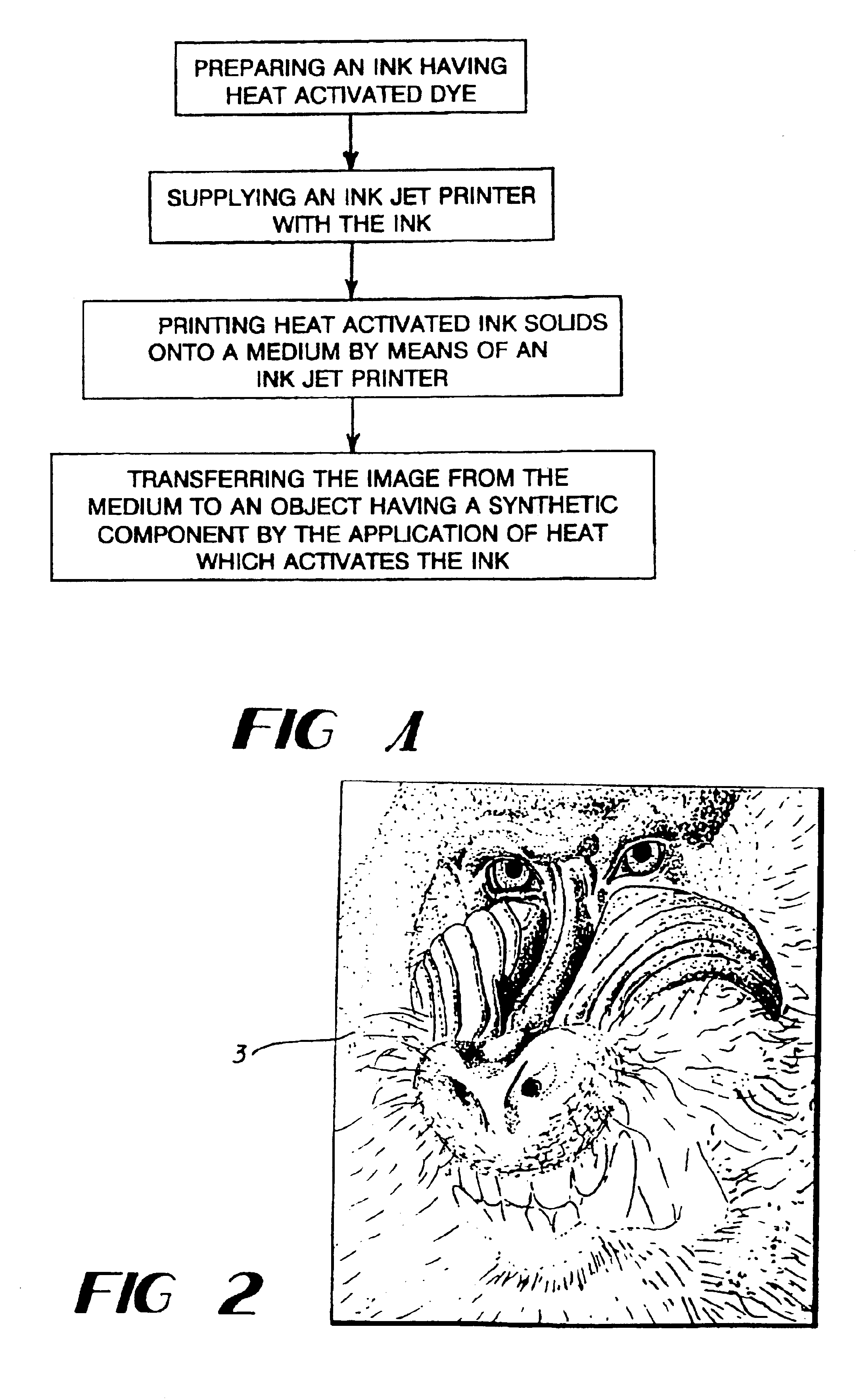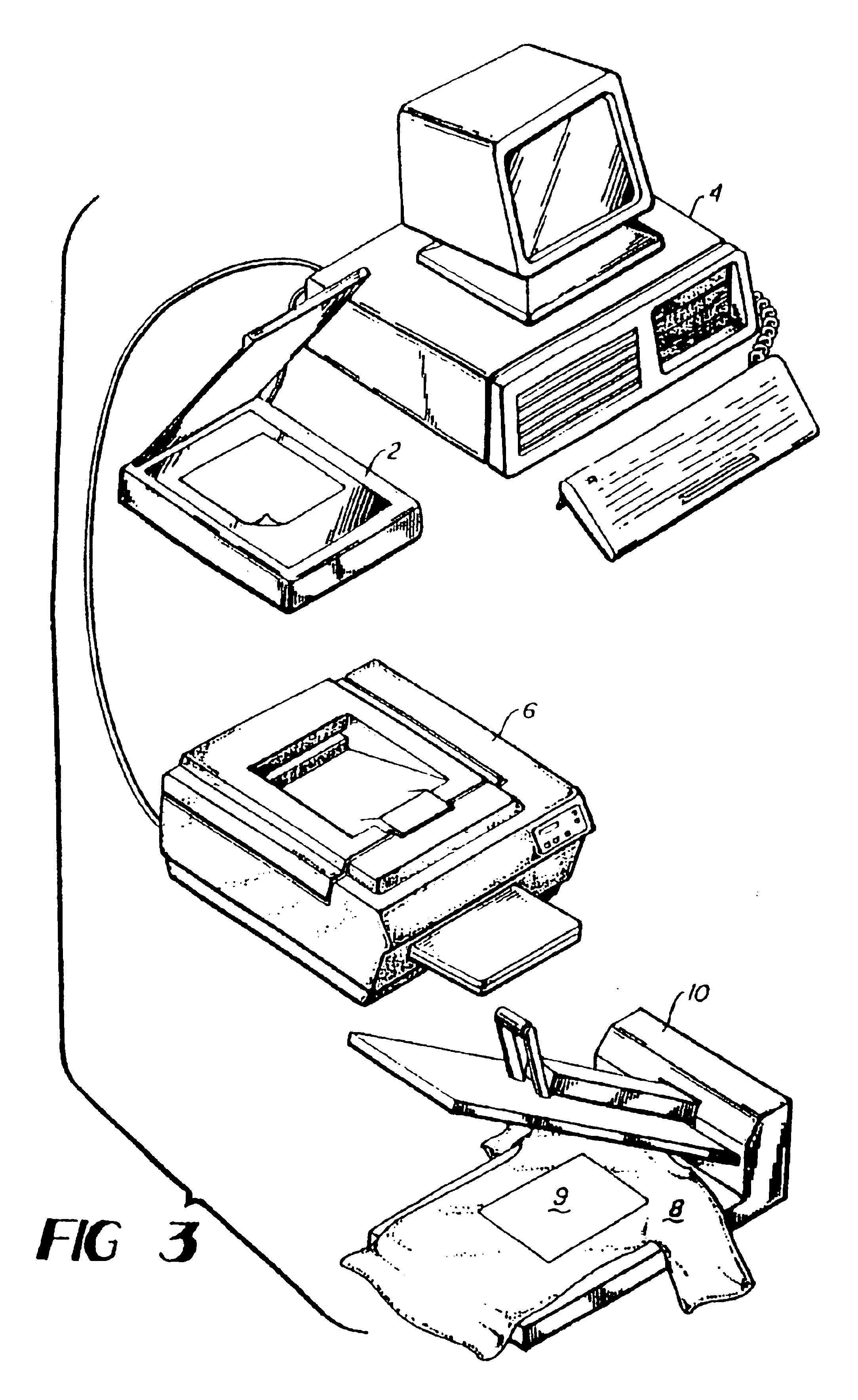Permanent heat activated ink jet printing process
a technology of heat-activated ink jet and printing process, which is applied in the field of printing, can solve the problems of dull colors and inability to meet the needs of most applications, and achieve the effect of preventing undesired activation and preventing agglomeration of dye particles
- Summary
- Abstract
- Description
- Claims
- Application Information
AI Technical Summary
Benefits of technology
Problems solved by technology
Method used
Image
Examples
formulation example # 1
FORMULATION EXAMPLE #1
Cyan Phase-Change Ink-Jet Ink Formula
[0038]
MaterialWeight %Sublaprint ® Blue 70014110.0Polywax ® PE500210.0Exxon FN ® 3505358.0DisperByk ® 18240.5Vinnapas ® B1.551.5Piccolastic ® A25610.0Polygard ®75.0Dibutyl Phthalate 5.0TOTAL:100.01Keystone Aniline Corporation 2Petrolite Corp. 3Exxon Chemical Co. 4BYK-Chemie, USA 5Wacker Chemicals (USA) 6Hercules Inc. 7Uniroyal Chemical Co.
[0039]Polywax PE500 is a transfer vehicle. This transfer vehicle is a wax-like polymer material. Exxon FN 3505 is a hydrocarbon wax used as part of the transfer vehicle. Other waxes or combinations could be used as the transfer vehicle depending on the printer, its operation temperature, the ink to be printed and the medium to be printed.
[0040]DisperByk 182 is an emulsifying enforcing agent. An anionic emulsifying enforcing agent should be used. DispersByk is a polymer type surfactant. Vinnapas B1.5 and Piccolastic are used as binders. Polygard is an antioxidant which is used for corrosion...
formulation example # 2
FORMULATION EXAMPLE #2
Yellow Ink-Jet Formula
[0048]
MaterialWeight %Bafixan ® Yellow 3FE82.0Dipropylene Glycol4.5DMSO1.5Cobratec ®90.45NaOH (10N)3.0Distilled H2O88.55TOTAL:1008BASF Corporation 9PMC Specialties Group
[0049]Formulation Example 2 comprises a heat activated yellow ink solid or dye. Dipropylene glycol and DMSO are co-solvents. Sodium Hydroxide is an inorganic emulsifying enforcing agent, which also acts as a fungicide. Distilled water acts as a solvent. Cobratec® acts as a corrosion inhibitor.
[0050]In this formulation, a particular ink solid is finely divided to yield a small particle size. The particular ink solid of Example 2 will tend to substantially dissolve within sodium hydroxide, which is used as the emulsifying enforcing agent. The combination of the sodium hydroxide and the solvent, which is the formulation example is distilled water, yield an emulsion which may be used in bubble jet and free flow ink jet printers.
[0051]Generically, a “humectant” is a moisturizin...
formulation example # 3
FORMULATION EXAMPLE #3
Cyan Ink-Jet Formula
[0052]
MaterialWeight %Sublaprint ® Blue 70013101.0Lignosol ® FTA113.5ME ® 392351210.0Diethylene Glycol9.5DMSO1.0Distilled H2O75.0TOTAL:100.0010Keystone Aniline Corporation 11Lignotech (U.S.) Inc. 12Michelman, Inc.
[0053]Sublaprint® Blue 70013 is a heat activated ink or dye solid. Lignosol® FTA and ME® 39235 is a polymer, and more specifically, it is a polyethylene binder. Diethylene Glycol and DMSO act as humectants. The solvent is distilled water.
[0054]Sublaprint® Blue 70013 is more difficult to sublimate than Bifaxan® Yellow 3GE, and is less soluble in the emulsifying enforcing agent. Diethylene glycol is used as a humectant to facilitate sublimation of the Sublaprint® Blue ink solid.
[0055]The heat activated ink solid is finely divided to a small particle size. The finely divided ink solid is combined with one or more emulsifying enforcing agents, which are in turn combined with the solvent.
PUM
| Property | Measurement | Unit |
|---|---|---|
| diameter | aaaaa | aaaaa |
| temperature | aaaaa | aaaaa |
| temperature | aaaaa | aaaaa |
Abstract
Description
Claims
Application Information
 Login to View More
Login to View More - R&D
- Intellectual Property
- Life Sciences
- Materials
- Tech Scout
- Unparalleled Data Quality
- Higher Quality Content
- 60% Fewer Hallucinations
Browse by: Latest US Patents, China's latest patents, Technical Efficacy Thesaurus, Application Domain, Technology Topic, Popular Technical Reports.
© 2025 PatSnap. All rights reserved.Legal|Privacy policy|Modern Slavery Act Transparency Statement|Sitemap|About US| Contact US: help@patsnap.com



